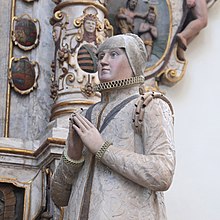Elisabeth of the Palatinate (1540–1594)
Elisabeth von der Pfalz (born June 30, 1540 in Birkenfeld , † February 8, 1594 in Wiener Neustadt ) was the second wife of Duke Johann Friedrich II of Saxony .
Life
Elisabeth's parents were the future Elector Friedrich III. von der Pfalz and Marie von Brandenburg-Kulmbach . She was the couple's third child and the second to reach adulthood. On June 12, 1558 Elisabeth married in Weimar Duke Johann Friedrich II. Of Saxony, the eldest son of the Saxon Elector Johann Friedrich the Magnanimous . The marriage resulted in four sons:
- Johann Friedrich (1559-1560)
- Friedrich Heinrich (1563–1572)
- Johann Casimir (1564–1633), Duke of Saxe-Coburg
- ⚭ 1. 1586 (deceased 1593) Anna of Saxony
- ⚭ 2. 1599 Margarete von Braunschweig-Lüneburg
- Johann Ernst (1566–1638), Duke of Saxony-Eisenach
- ⚭ 1. 1591 Elisabeth von Mansfeld
- ⚭ 2. 1598 Christine von Hessen-Kassel
Johann Friedrich II had chosen Grimmenstein Castle in Gotha as his residence . After Elector August von Sachsen besieged the town and castle as part of the Gotha War and conquered it on April 13, 1567, Duke Johann Friedrich the Middle was imprisoned by the emperor and was brought to Wiener Neustadt via Dresden in June 1567 . Duchess Elisabeth had to move with her children first to Eisenach and then to her sister Dorothea Susanne, married to Duke Johann Wilhelm I of Saxe-Weimar , her husband's brother, to Weimar . At the end of 1568 she moved back to Eisenach, first to the Zollhof, then to the Wartburg , and finally to the castle in Eisenberg .
In the following years she wrote a large number of letters of petition, among others to Emperor Maximilian II , Empress Maria and the Electress Anna of Saxony , in order to obtain the release of her husband. With the help of her father and her brothers, she succeeded in 1570 at the Reichstag in Speyer , where she was allowed to fall in front of Emperor Maximilian II in her father's castle in Heidelberg , to reinstate her sons as princes with inheritance rights. Until Erfurt sharing agreement from November 6, 1572 was Duke Johann Wilhelm I of Saxony-Weimar guardian of the children, after that it was next to Johann Georg (Brandenburg) (from 1578 Margrave Georg Friedrich von Brandenburg-Ansbach ) and Elector Frederick of the Palatinate also Elector August of Saxony , who provided for an education under his supervision and in his interest.
In the summer of 1572 Elisabeth moved into captivity with her husband in the castle of Wiener Neustadt . From there she returned to Coburg twice. On August 5, 1572, the son Friedrich Heinrich died in Eisenberg. The two youngest sons Johann Casimir and Johann Ernst moved to the Ehrenburg in Coburg on December 5, 1572 , where they grew up under the governorship of Count Barbys, a confidante of Elector August.
In June and July 1578 Elisabeth drove via Prague, where she unsuccessfully wanted to speak to Empress widow Maria, to Coburg, where she met her younger sister Dorothea Susanna. In 1583 Elisabeth traveled from March to August via Prague and Coburg to Weimar to attend the wedding of Friedrich Wilhelm with Sophia von Württemberg on May 5th and to speak to Elector August. However, the elector canceled. The way back took her to her brother, Elector Ludwig VI. from the Palatinate in Heidelberg, where her sons were allowed to accompany her.
On February 8, 1594, Elisabeth died in the armory in Wiener Neustadt. Her heart and bowels were buried separately in the Winzendorf branch church . It was a patronage church of the Austrian Protestant aristocratic family Teufel, who were friends with the duke couple. At the end of the year, the Duchess's body was taken home and on December 30, 1594, she was buried in the Morizkirche in Coburg . In 1598, Duke Johann Casimir had his parents, Johann Friedrich II of Saxony died in 1595, put a twelve-meter-high alabaster tomb made of Heldburg alabaster by the Heldburg sculptor Nikolaus Bergner , which is one of the most beautiful Renaissance epitaphs in Germany.
literature
- August von Kluckhohn: Elisabeth (Duchess of Saxony) . In: Allgemeine Deutsche Biographie (ADB). Volume 6, Duncker & Humblot, Leipzig 1877, p. 38.
- Joachim Kruse: Duke Johann Friedrich II. The Middle of Saxony (1529–1595) and the Ernestine family epitaph in St. Moriz, Coburg, completed in 1598. A study of the history of culture and art. Part 1 . In: Yearbook of the Coburger Landesstiftung 2007 , ISSN 0084-8808 , pp. 1–334.
Web links
| personal data | |
|---|---|
| SURNAME | Elisabeth of the Palatinate |
| ALTERNATIVE NAMES | Elisabeth of Pfalz-Simmern |
| BRIEF DESCRIPTION | Duchess of Saxony |
| DATE OF BIRTH | June 30, 1540 |
| PLACE OF BIRTH | Birkenfeld (Nahe) |
| DATE OF DEATH | February 8, 1594 |
| Place of death | Wiener Neustadt |


